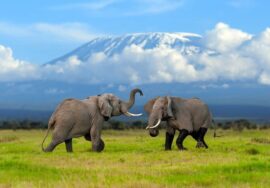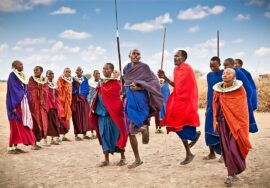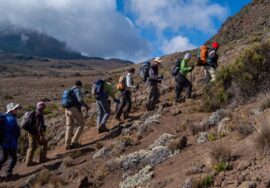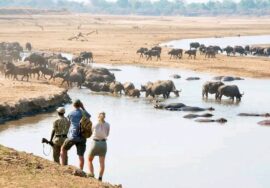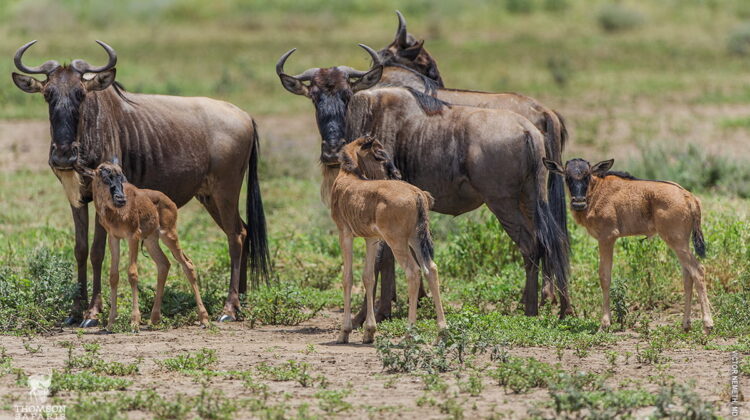
Wildebeest Calving / Wildebeest Calving Season
Wildebeest Calving / Wildebeest Calving Season. Wildebeest calves are born in interesting places, and it can be interesting to see the long journey they have to take. During the Great Wildebeest Migration in Tanzania and Kenya, you can see these unusual sights.
Where do the 1.5 million wildebeest come from, and how many babies do they have? Find out more about the wildebeest birth season and the other animals that are active during this beautiful time by reading on.
In what place does the calving season start?
We start in the southern fields of the Serengeti, where water grass and red oats grow in large amounts after the short rainy season in November. There is now a full plain.
We can see big groups of wildebeest going over the east side of the Serengeti from this spot.
After that, the herd moves clockwise to nearby places like Lake Masek and the Ngorongoro protection area. When the calves are born, the herd moves north to Kenya’s Masai Mara.
This is the busiest time of the year because the calves can get the best milk because the earth and grass are high in potassium, calcium, and phosphorus. Also, because the grass is short, predators can’t hide and attack without being seen.
Since the Grumeti river is low, they go west to get to it on their way north. Adult wildebeests drink about 3 gallons (14 liters) of water every day.
The crocodile-filled holes they have to go through before they can cross the Mara river in Kenya are a big risk.
This is a risk that comes with farming on land that has a lot of grass. They can be seen feeding on thick, long grass all the time because they need to keep their weight up for this tough season.
How does the process work?
Now we have groups of wildebeest living in the same area. In January, the pregnant wildebeest give birth, and this keeps happening until March, when up to 8,000 calves are born every day.
In order to keep the females and calves safe from predators like lions, cheetahs, and hyenas, these calves are usually born in the middle of their groups.
During these months, up to 500,000 calves are born, which means the group is about to get a lot bigger.
It all ends with more than a million wildebeest, which is thought to be one of the seven natural wonders of the world.
It’s amazing that these calves can walk and run at full speed within minutes of being born. This lets them make their way to freedom.
Are there any risks this Christmas season?
During the migration, it can be hard for the young calves to keep up with the bigger animals in their group. They may get lost, which gives predators a chance to attack.
During this journey, about 250,000 wildebeests often die. This can happen because they are thirsty, hungry, weak, or because of climate change, which can make it dangerous for them to stay alive during this season.
This can lead to heavier rain and storms, which can change the rivers and the amount of grass that wildebeests can eat. Wildebeests are very important to the ecosystem’s long-term renewal.
Will there be other animals in the mix?
Throughout the year, tens of thousands of zebras and gazelles have been following the wildebeests.
This is no different, as they use this time to give birth to their own young because the cover of many wildebeests gives them great security.
There may be as many as 200,000 zebras and 500,000 gazelles on their way back to the northern Serengeti and across the rivers.
Over 2 million animals can live in this area, and there are now over 7500 hyenas, 4,000 lions, and up to 600 cheetahs.
When is the best time to see the wildebeest giving birth?
If possible, you should plan your trip for sometime between the end of December and March. February is the best month because many tented camps are set up in the migration route.
This way, you can see what’s going on, and there are a lot of different kinds of places to stay in the area that you can use to see the event.
This can happen during the calving season in Ndutu, which lasts from the middle of December to the middle of March. The movement happens all year, so you can also see this amazing show in the central and northern Serengeti.
You can go in the middle of July to see the famous river bridge. There are also trips that you can take by car or on foot that can be just as exciting. A hot air balloon safari might be the best way to see how big this activity is.
In conclusion
Now that you know how this season goes, you can see that there are a lot of risks and amazing things that you have to see to believe. With that in mind, you can get ready for a safari tour, which is very popular with people who love the outdoors.


